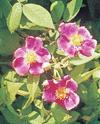- rosé
-
/roh zay"/, n.a pink table wine in which the pale color is produced by removing the grape skins from the must before fermentation is completed.[1425-75; < F: lit., pink]
* * *
IAny of about 100 species in the genus Rosa (family Rosaceae) characterized by their beautiful, fragrant flowers.Rosa species are probably the most widely recognized and universally favoured of ornamental flowering plants. Hundreds of varieties are cultivated in all types of settings, and there are many hybrids. Roses are susceptible to numerous diseases, most caused by fungi. The rose family contains about 3,000 species and accounts for 45% of the species in the rose order (Rosales). Other popular garden plants and ornamentals in the rose family include spirea, cinquefoil, hawthorn, mountain ash, and flowering cherry. The family also contains many important fruits, including the apple, peach, strawberry, pear, plum, apricot, almond, quince, blackberry, and raspberry. Plants of some species contain dangerous cyanide compounds. Many members have thorns or prickles. Prairie rose (Rosa setigera).John H. GerardII(as used in expressions)Marie Josèphe Rose Tascher de la PagerieLee Gypsy RoseRose Louise HovickRomance of the RoseRose of Lima SaintRose FredRose Peter EdwardPasadena Tournament of RosesRoses Wars of the
Prairie rose (Rosa setigera).John H. GerardII(as used in expressions)Marie Josèphe Rose Tascher de la PagerieLee Gypsy RoseRose Louise HovickRomance of the RoseRose of Lima SaintRose FredRose Peter EdwardPasadena Tournament of RosesRoses Wars of the* * *
▪ plantany perennial shrub or vine of the genus Rosa, within the family Rosaceae, an almost universally distributed group of some 100 species. The great majority are native to Asia. Many are cultivated for their beautiful, fragrant flowers. These are commonly white, yellow, orange, pink, or red and, in wild roses, are borne singly or in small clusters. The flowers of wild roses usually have five petals, while the flowers of cultivated roses are often double (i.e., with multiple sets of petals).Roses are erect, climbing, or trailing shrubs whose stems are usually copiously armed with prickles of various shapes and sizes that are called thorns. The plant's leaves are alternate and pinnately compound (i.e., feather-formed). The rather oval leaflets are sharply toothed. The rose plant's fleshy, sometimes edible, berrylike “fruit” (actually the floral cup) is known as a hip.Roses are native primarily to the temperate regions of the Northern Hemisphere. Most rose species are native to Asia, with smaller numbers being native to North America and a few to Europe and northwest Africa. Roses from different regions of the world hybridize readily, giving rise to types that overlap the parental forms, and making it difficult to determine basic species. Of the more than 100 species of roses, fewer than 10 species (most native to Asia) were involved in the crossbreeding that ultimately produced today's many types of garden roses.There are several major classes of garden roses. The best-known and most popular class of rose are the hybrid tea roses, which account for the majority of roses grown in greenhouses and gardens and sold in florist shops. Hybrid teas come in the complete range of rose colours and have large, symmetrical blossoms. Hybrid teas resulted from the crossbreeding of frequently blooming but fragile tea roses with vigorous hybrid perpetual roses. The hybrid perpetuals achieved great popularity until they were supplanted by the hybrid teas in the early 20th century. Polyantha roses are a class of very hardy roses that produce dense bunches of tiny blossoms. Floribunda roses are hardy hybrids that resulted from crossing hybrid teas with polyanthas. Grandiflora roses are relatively new hybrids resulting from the crossbreeding of hybrid teas and floribunda roses. Grandifloras produce full-blossomed flowers growing on tall, hardy bushes. Among the other classes of modern roses are climbing roses, whose slender stems can be trained to ascend trellises; shrub roses, which develop into large bushes; and miniature roses, which are pygmy-sized plants bearing tiny blossoms. Altogether there are approximately 13,000 identifiable varieties of roses in these and other classes.No other flower is so universally known and admired as that of the rose. Its blossoms range in colour from white through various tones of yellow and pink to dark crimson and maroon. Many varieties have been bred with beautiful blends of colour. Rose flowers' size ranges from tiny miniatures 1.25 cm (0.5 inch) in diameter to flowers measuring more than 17.5 cm (7 inches) across. Roses have a delightful fragrance, which varies according to the variety and to climatic conditions.Roses can become infected by a number of diseases, most of them caused by fungi. Powdery mildew appears as a grayish white moldlike growth on the surface of young leaves and stems. Black spot fungus appears as conspicuous black spots on leaves and causes them to fall off. Rust is also a common disease of roses.Attar of rose (attar of roses), used in perfumes, is obtained from the rose blossoms, especially those of the damask rose (R. damascena). Rose hips, particularly those of R. rugosa, are a source of vitamin C and are sometimes used in preserves.* * *
Universalium. 2010.
